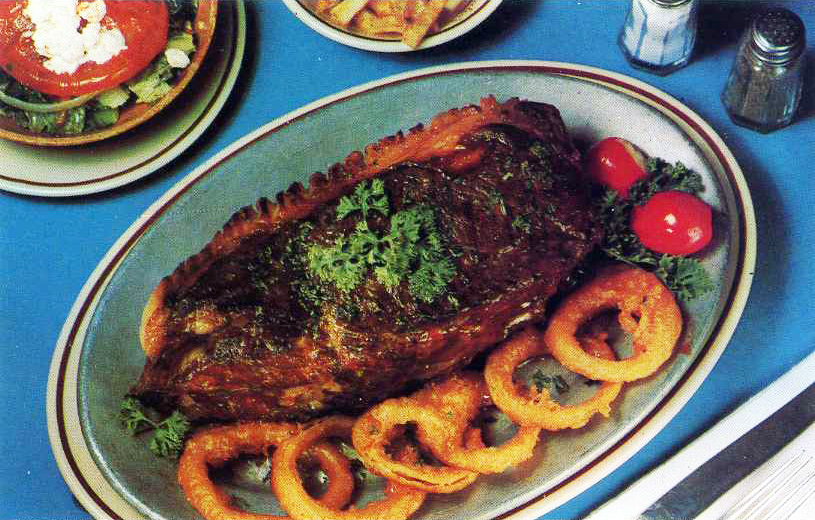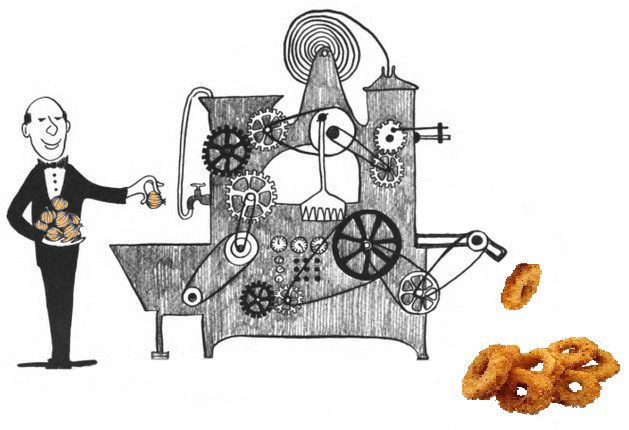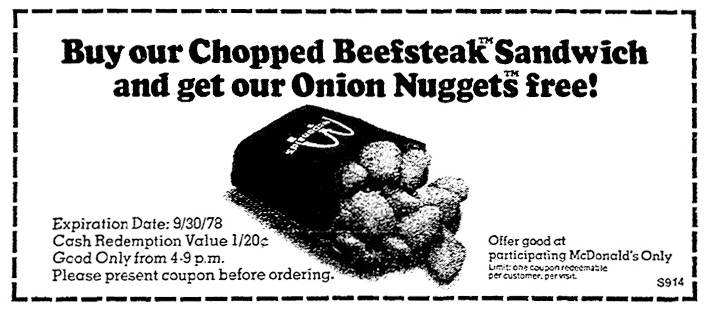It’s hard to say just how long french fried onion rings have been on restaurant menus. But it’s likely that they were served at the Grove Park Inn, in Asheville NC, shortly after it opened in 1913. A few years later politician William Jennings Bryan’s recipe for them appeared in a Boston newspaper in which he said that the inn was the first place he – a frequent traveler – had ever encountered them.
Women had been preparing them in their homes before that. A recipe appeared in Women’s Home Companion in 1905, but I’m sure they were known earlier.
Bryan’s recollection as well as the 1905 recipe settle the question of whether french fried onion rings were the 1920s invention of a Pig Stand in Texas as frequently claimed on the internet. They were not.
In the 1930s onion rings became more common in restaurants, probably aided by improvements in cooking oil (though many used lard) and deep fryers. Then, and for several decades later, they were usually featured as an accompaniment to a steak. In the heart of the Depression Schrafft’s advertized its Sizzling Steak Combination, saying, “With it you get generous helpings of French fried potatoes, onion rings or a fresh vegetable, a green salad, and a pot of Schrafft’s coffee, $1.50.” It ended with the tagline, “A Man’s Meal.”
They were often specifically marketed to men. Whether women shied away from them because of fear of breath contamination or some other stigma is unclear. Or maybe they enjoyed them just as much as men did, but were less likely to order steak because of price.
Despite the fact that men liked onion rings, onions in general carried a stigma. At various times in the last century they were characterized as “ordinary and even common,” as breath contaminators, and as food that restaurant kitchen workers did not like to handle. A 1966 handbook recommended that restaurant operators drawing up menus “shun” onions, along with lamb kidneys, pig’s knuckles, parsnips, turnips, and rutabagas. In 1969 a Gallup Poll found that potatoes were Americans’ favorite vegetables, followed by green beans, asparagus, corn, and tomatoes. French fried onions were ranked as slightly more popular than broccoli, lima beans, and peas.
Prejudices aside, onion rings grew more popular over time.
The arrival of pre-breaded frozen onion rings, which saved kitchen labor, was almost certainly part of their rising popularity. Their production began in the early 1950s when food companies contracted with fish processors who had learned the art of breading and freezing. Contra the Gallup poll, in 1969 one writer acknowledged that, after french fries, onion rings “must be the all time favorite accompaniment to hamburgers.”
Use of the ready-to-heat rings increased in the 1970s when fast food chains began to serve them. Some, such as those sold at Burger King, were made of ground onions that had been extruded through tubes in factories. Their uniform size and shape, suited for “portion control,” did not sit well with a restaurant reviewer in 1977. He complained that a Burger King in Seattle served onion rings that were “those pressed-onion jobs that come out all one size and lacking a great deal of onion taste.” What an ingrate! Didn’t he realize that extrusion meant he could count on always receiving the exact same number of grams of breading and ground onion as the next customer?
In 1978 McDonald’s began test-marketing their own version of deep fried onions, using chunks instead of rings and calling their “french fried chopped onion product” Onion Nuggets. But the nuggets didn’t make it past the test stage, reputedly because they got cold too quickly. Restaurant onion rings, in general, were often criticized for being served cold – as well as for being limp and greasy.
Overall, the historic trajectory of onion rings in restaurants seems to be:
- Beginning in the early 20th century primarily as a garnish or accompaniment to a steak
- Especially as onion prices rose, becoming a separately priced side order, often where hamburgers were popular such as drive-ins and fast food outlets.
- Ascending to the top of the menu — with inflated prices — as appetizers at dinner-house chains such as TGI Friday.
Though not ring-shaped, Outback Steakhouse’s “Bloomin’ Onion” may have propelled deep fried onions to their historic pinnacle both in terms of fat and calorie load as well as price.
© Jan Whitaker, 2021


















 It's great to hear from readers and I take time to answer queries. I can't always find what you are looking for, but I do appreciate getting thank yous no matter what the outcome.
It's great to hear from readers and I take time to answer queries. I can't always find what you are looking for, but I do appreciate getting thank yous no matter what the outcome.



THANKS Jan for this tribute to one of my favorite, and most “uniquely American” foods. Like many of them though, onion rings started as a special delicacy then gradually became just another tired menu item. While the mass-produced versions enabled portion accuracy, fast food proliferation, etc. they definitely tarnished the “brand.”
As a little boy in the 60’s (when eating out was more of a “special occasion” than it is now), I first had them at King’s Barbeque restaurant (southside VA) where they were served thinly sliced/lightly breaded, more like a heap of onions than individual rings. They were a special treat to be savored when visiting grandparents (and other relatives) who lived there.
Later as a fast-food eating teenager in the 70’s the Burger King “ground onion” rings were introduced, and I was able to enjoy them more often, albeit in a more processed, less gourmet version. My very first job was working the taco/onion ring fryer at Jack-in-the-Box, (in suburban NoVa during their brief operation there), where a similar version was served. Having seen these “behind the scenes” I was definitely “done” before long.
Soon I moved up the hospitality industry ladder (a little) however, working as a room service waiter (in a groovy red bolero jacket with brocade lapels!) at the Dulles Marriott. This introduced me to “real” onion rings (made from sliced onions) and breaded (key term); which were available as either appetizer, or garnish on open-faced steak sandwiches (served on toast points, thank you). Sometimes the line cook would throw a couple extra in the fryer for me to brighten up my shift. At the Marriott I learned that onion rings are best (to me, anyway) when prepped with the 3-step (flour, egg wash, bread crumbs/cracker meal) method.
Restaurants like Houlihan’s, etc., brought out the “beer batter” variety onion rings in the 1980’s. Quite popular in some circles, they were often soggy/heavy, almost like donuts – BLECH!. When I could find them though, the breaded type continued to be one of my favorites.
Flash forward to 1997/98. While with the Navy Reserves, I was deployed with NATO on an 9-month (extended to 11 months) assignment in Sarajevo, BiH, where my duties included administering the grocery/provisions contracts for the NATO dining facilities. A lot of ex-pats/military personnel were there then, and a Tex-Mex restaurant opened up. Quite an anomaly for a Balkan city, but they found a popular niche and did quite well. Their kitchen included what was at that time, a rare appliance in Sarajevo, a deep fryer. What their menu could NOT include though, was guacamole, as avocados were just as rare. By coincidence, I was able to connect the restaurant owners with a grocery provider down in southern Croatia, which led to an almost-regular supply, and ultimately, guacamole.
The owner wanted to do something in return, and I told them how I was homesick for onion rings. While onions were plentiful, onion RINGS were unheard of in Bosnia. I had remembered JUST enough from my days at Marriott to show it to one of their cooks the aforementioned “3-step” preparation method, they became an occasional “appetizer special.” It’s always these little tastes of home that ward off homesickness, and these Tex-Mex onion rings did the trick for me.
Sorry for the long post, but onion rings have been strangely intertwined with my life/career, and I thought some of you might enjoy the story.
Interesting! I wonder if they are still being eaten in Bosnia.
The most surprising part of the post (other than the idea of extruded onion rings … yuck) is the 1969 survey result showing asparagus in third place!
I agree.
When we were living in Beijing there was a Japanese restaurant we went to fairly often which produced the most fabulous onion rings. They were part of the mixed vegetable Tempura dish on the menu, So, Tempura Onion Rings, stunningly light and crispy – no heavy oily coating – a truly delicious bite; After reading this post I plan to have a go at re-creating them!
Sounds so good!
Thank you for all the hard work you do to put these interesting and informative blog posts together. You are much appreciated!
It’s well worth it to me. And big thanks for your message.
Onion Rings and Onion Blossoms!
These are eaten mostly in restaurants and at fairs.
I will never forget how, due to the Covid pandemic, restaurants and fairs were shut down, and much of the already-planted onion crop had to be plowed under.
This was true for many crops, as well as milk, eggs, chickens, etc. Doubly sad, as there were so many more out-of-work people who could have used all the excess food intended for restaurants, schools, institutions, etc.! As a country, not only were many folks sick or quarantining – we do not have the labor, infrastructure and supply chains to switch gears and load, store, refrigerate, and re-distribute the food where it was needed. Sigh…
Yes, that was indeed a lesson in wastefulness.
What would be the best ever onion ring recipe 😂
Hard to say. I have the impression that most recipes are pretty much similar.
How much of our food is extruded, actually? (Aside from Pringles.)
Good question.
In addition to Pringle’s are probably the most “extruded” snack food of all – FunYuns!
I tried to change my email address but I was not able to.
NEW ADDRESS: cerubin7@gmail.com
Thank you.
Cynthia Elyce Rubin
>
Cynthia, I can’t find your old email in the follower list so I sent you an invitation to follow. Hopefully that will work. J.